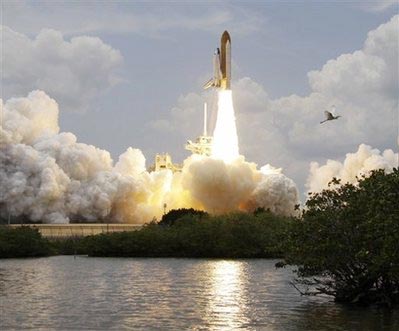Dangerous stalking American space shuttle
After leaving the launch pad to fly to the Hubble Space Telescope, the Atlantis spacecraft entered a space of several thousand pieces. They move around the earth at nearly 9 km / sec and can cause catastrophe if hitting the ship.

Atlantis was launched from the Kennedy Space Center in the state of Florida, USA on May 11, 2009.Photo: AP.
Among the rubbish around Atlantis, there are satellite debris and used missiles. Never had the crew of the crew seen so much garbage on Earth's orbit. They will have to stay in orbit for more than a week to fix the Hubble Space Telescope. After the repair is completed, the ship will arrive at a safe location.
The Hubble Space Telescope operates at 610 km above the ground. It is the most littered orbit compared to the orbits that spacecraft often fly. Even the smallest debris can cause disaster when it collides with the spacecraft.
After the accident of Columbia in 2003, flying to Hubble glass was considered an extremely dangerous task. Since Hubble is not in the same orbit as the International Space Station, astronauts cannot use the station as a safe haven in an emergency. The US Aeronautics Agency (NASA) believes that the probability of collisions between spacecraft and garbage is 1/229 - much higher than flights to international space stations.
Today, Atlantis will approach the telescope and take it to the ship's cargo compartment. Here the astronauts will upgrade and repair glass from tomorrow.
Yesterday they checked outside the ship to see if it was damaged by debris during the launch. Since cosmic garbage revolves around the globe at a tremendous speed, an object that is one-third the width of a coin can also penetrate the spacecraft's cockpit.
The place where Atlantis stopped became more and more "crowded" in recent years. In 2007, China destroyed one of their satellites during a missile test. Satellite debris scattered everywhere. In February of this year, a dead Russian satellite collided with an American telecommunications satellite, causing the number of garbage to continue to rise.
So far, the detectors have detected about 950 debris from this collision and more than 2,500 pieces from the 2007 satellite explosion. Of course, there are still thousands of fragments that the devices have not yet discovered .
Astronomer Jonathan McDowell of Harvard University (USA) - a cosmic garbage expert - commented: 'People are closely monitoring every Atlantis ship activity. It is a really dangerous task. '
- 30 years after the shuttle explosion shocked the United States
- NASA tested the new generation shuttle
- Train shuttle shuttle derails
- Atlantis space shuttle re-exported at the exhibition
- Which vehicle will replace NASA space shuttle?
- How is NASA's shuttle fleet now?
- The first US shuttle is about to be re-exported.
- American spacecraft left the launch pad
- The American shuttle returns to Earth
- Space shuttle Endeavor returns safely to earth
- American shuttle was damaged after testing
- Astronauts have trouble walking in the universe
 Van Allen's belt and evidence that the Apollo 11 mission to the Moon was myth
Van Allen's belt and evidence that the Apollo 11 mission to the Moon was myth The levels of civilization in the universe (Kardashev scale)
The levels of civilization in the universe (Kardashev scale) Today Mars, the sun and the Earth are aligned
Today Mars, the sun and the Earth are aligned The Amazon owner announced a secret plan to build a space base for thousands of people
The Amazon owner announced a secret plan to build a space base for thousands of people